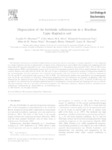Por favor, use este identificador para citar o enlazar este ítem:
http://www.alice.cnptia.embrapa.br/alice/handle/doc/15602Registro completo de metadatos
| Campo DC | Valor | Lengua/Idioma |
|---|---|---|
| dc.contributor.author | MARTINEZ, C. O. | pt_BR |
| dc.contributor.author | SILVA, C. M. M. de S. | pt_BR |
| dc.contributor.author | FAY, E. F. | pt_BR |
| dc.contributor.author | MAIA, A. de H. N. | pt_BR |
| dc.contributor.author | ABAKERLI, R. B. | pt_BR |
| dc.contributor.author | DURRANT, L. R. | pt_BR |
| dc.date.accessioned | 2016-11-23T23:01:39Z | - |
| dc.date.available | 2016-11-23T23:01:39Z | - |
| dc.date.created | 2008-12-22 | pt_BR |
| dc.date.issued | 2008 | pt_BR |
| dc.identifier.citation | Soil Biology and Biochemistry, v. 40, n. 4, p. 853-860, 2008. | pt_BR |
| dc.identifier.uri | http://www.alice.cnptia.embrapa.br/alice/handle/doc/15602 | pt_BR |
| dc.description | The herbicide sulfentrazone is classified as highly mobile and persistent and this study aimed to examine degradation of this compound on a Typic Hapludox soil that is representative of regions where sulfentrazone is used in Brazil. Soil samples were supplemented with sulfentrazone (0.7 mg active ingredient (a.i.) g1 soil), and maintained at 27 1C. Soil moisture was corrected to 30%, 70%, or 100% waterholding capacity (WHC) and maintained constant until the end of the experimental period. Soils without added herbicide were used as controls. Aliquots were taken after 14, 30, 60, 120, 180, and 255 days of incubation for quantitative analysis of sulfentrazone residues by gas chromatography. Another experiment was conducted in soil samples, with and without the herbicide, at different temperatures (15, 30, and 40 1C), with moisture kept constant at 70% of WHC. The sulfentrazone residues were quantified by gas chromatography after 14, 30, 60, and 120 days of incubation. Sulfentrazone degradation was not affected by soil moisture. A significant effect was observed for the temperature factor after 120 days on herbicide degradation, which was higher at 30 1C. A half-life of 146.5 days was recorded. It was observed that the herbicide stimulated growth of actinomycetes, whereas bacterial and fungal growth was not affected. The microorganisms selected as potential sulfentrazone degraders were Rhizobium radiobacter, Ralstonia pickettii, Methylobacterium radiotolerans, Cladosporium sp., Eupenicillium sp., and Paecilomyces sp. | pt_BR |
| dc.language.iso | eng | eng |
| dc.rights | openAccess | eng |
| dc.subject | Degradação | pt_BR |
| dc.title | Degradation of the herbicide sulfentrazone in a Brazilian typic hapludox soil. | pt_BR |
| dc.type | Artigo de periódico | pt_BR |
| dc.date.updated | 2016-11-23T23:01:39Z | pt_BR |
| dc.subject.thesagro | Herbicida | pt_BR |
| riaa.ainfo.id | 15602 | pt_BR |
| riaa.ainfo.lastupdate | 2016-11-23 | pt_BR |
| dc.contributor.institution | Camila Ortiz Martinez, Embrapa Meio Ambiente; Célia Maria Maganhotto de Souza Silva, Embrapa Meio Ambiente; ELISABETH FRANCISCONI FAY, CNPMA; ALINE DE HOLANDA NUNES MAIA, CNPMA; Rosângela Blotta Abakerli, Embrapa Meio Ambiente; Lucia R. Durrant, Faculdade de Engenharia de Alimentos-UNICAMP. | pt_BR |
| Aparece en las colecciones: | Artigo em periódico indexado (CNPMA)  | |
Ficheros en este ítem:
| Fichero | Descripción | Tamaño | Formato | |
|---|---|---|---|---|
| 2008AP20.pdf | 200,28 kB | Adobe PDF |  Visualizar/Abrir |









